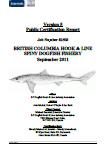BC Spiny Dogfish Fishery certified as sustainable

World’s first spiny dogfish fishery receives MSC certification for sustainable fishing
News Release by the Marine Stewardship Council (MSC)
13. September 2011
The British Columbia, Canada spiny dogfish (Squalus suckleyi) fishery has received Marine Stewardship Council (MSC) certification as a sustainable fishery following an independent, scientific assessment conducted by an accredited certification body, Moody Marine Limited. This means that the independent scientific assessment team concluded that the fishery met the MSC’s global standard for sustainable fisheries which includes healthy fish stocks, minimal ecosystem impacts, and an effective fisheries management system. The fishery was entered into assessment by the BC Dogfish Hook & Line Industry Association, an organization representing more than 90% of the vessels fishing dogfish and all processors that convert the fish into market ready products.
Conservative harvest levels and stable stocks over 20 years
The spiny dogfish fishery is managed within the precautionary framework of the Department of Fisheries and Oceans Canada (DFO). DFO Canada sets the annual total allowable catch levels based upon the long-term average yield of the fishery. Catch levels over the last 20 years have been approximately 3,000 tonnes annually, which is below the annual allowable catch. Reviews conducted in 2009 concluded that spiny dogfish stock levels are stable and that current catch levels were unlikely to cause harmful stock declines. In 2011, DFO Canada set an even lower allowable catch, as a further precautionary measure.
Low bycatch and minimized habitat impact from fishery
The assessment team concluded that the bottom long lines used in the certified fishery resulted in a selective fishery with more than 90 per cent of catch weight made up of the target species. Although the fishery encounters a broad range of other species, including some endangered, threatened and protected (ETP) species, the numbers encountered are very low and survival rates high. Catches are monitored by a sophisticated monitoring system that combines on-board cameras which records all catch, logbooks that are maintained by the fishing boat captains, and audits of the system that are conducted by independent auditors
The assessment further found that the bottom long lines used by the fishery have a relatively low impact on the seabed and that the fishery was unlikely to have a significant impact upon the coastal habitat.
Measures to improve scientific understanding part of the process
The assessment team also identified some areas for improvement. As a result, in each of two areas where fishing occurs, the same three improvement actions are required to be carried out during the five year period of certification. They are: An analytical stock assessment has to be developed, implemented and accepted by the management authority. 2. There has to be evidence for successful implementation of a comprehensive sixgill shark management plan. 3. A research plan has to be developed, implemented and updated to inform management.
What the fishery says
Mike Renwick, BC Dogfish Hook & Line Industry Association, said their fishermen and processor members are very pleased to have completed this major milestone in sustainability certification of their fishery. Renwick said special thanks are due to the “many stakeholders who worked alongside us to ensure a robust and transparent process in this complex assessment”. He also hopes the assessment and certification will serve to improve the economics of this relatively small but important fishery.
What the MSC says
Kerry Coughlin, MSC Americas Regional Director, said: “On a global basis, many species in the shark family are vulnerable to overfishing. The BC spiny dogfish fishery is the first of its type to demonstrate, through assessment to the MSC’s rigorous, scientific standard, that the fishery is being conducted and managed in a sustainable manner. We hope this will inspire other fisheries harvesting this species to achieve this bar.”
MSC certificate only applies to line-caught spiny dogfish from British Columbia
The B.C. spiny dogfish fishery is defined by stock, area and gear and the certification applies only to the two defined fishing areas that were entered into assessment by the association. Currently, 24 vessels are registered to particpate in the certified fishery. In 2009/10 directed dogfish hook & line vessels accounted for 92 percent of the total spiny dogfish landings of British Columbia. The remaining eight percent were landed by the trawl fishery (not part of the assessment and thus not certified to the MSC standard), or as bycatch in other BC hook & line fisheries.
The fishery certified today occurs in two stocks in the northern Pacific and is distinguished from the closely related common spiny dogfish (Squalus acanthias) that can be found in waters in many other parts of the world. The fishery operates along the coast of the Canadian province of British Columbia. In 2009/10 the hook and line fishery caught a total of 3,147 tonnes of spiny dogfish.
The spiny dogfish of the certified fishery are landed whole and processed into fresh and frozen products and exported to European and Asian markets. The remainder of the fish after processing for human consumption is converted into organic fish fertilizer for agriculture and cartilage is extracted for use in nutritional supplement products.
Source: Marine Stewardship Council (MSC)
 Additional Information (PDF File):
Additional Information (PDF File):
Public Certification Report (Version 5)
